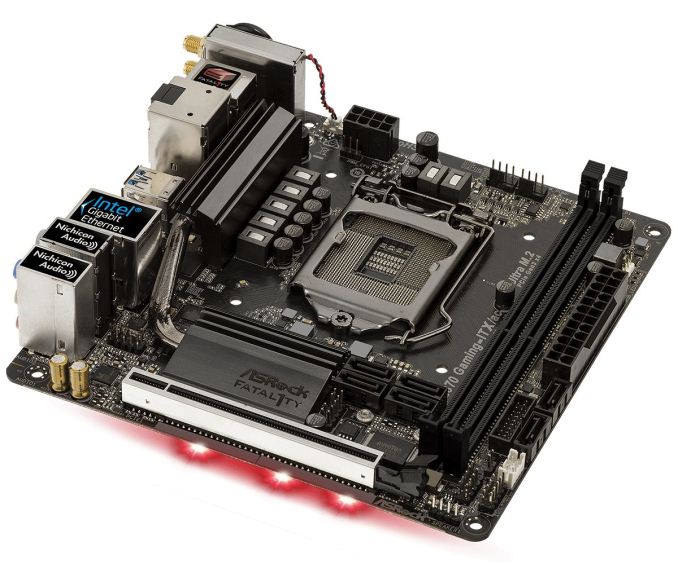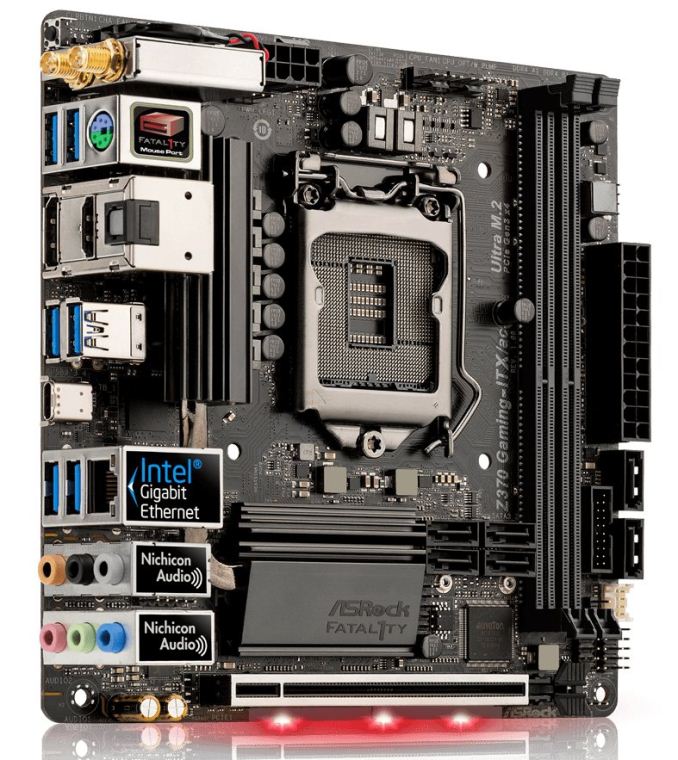The ASRock Z370 Gaming-ITX/ac Motherboard Review: Mini-ITX with Thunderbolt 3
by Joe Shields on July 13, 2018 9:00 AM EST- Posted in
- Motherboards
- Gaming
- Intel
- ASRock
- Mini ITX
- 802.11ac
- Wi-Fi
- Coffee Lake
- Z370
- i7-8700K
Conclusion: Your New Motherboard
Prospective buyers looking for Mini-ITX boards are typically looking for a small footprint but still want features. Boards like this depend on the creativity of the board maker to determine what parts can go where. The ASRock Z370 Gaming-ITX/ac is one of the most fully featured small form factor boards we have seen in a long while.
Top of the feature list is the fact that there is a Alpine Ridge controller on the motherboard, giving access to a Thunderbolt 3 Type-C port. This port can also accept USB 3.1 devices, act as a Displayport output over Type-C, and also supports Power Delivery 2.0 up to 36 W for fast charging other devices. It's rare to see this on most Z370 motherboards, let alone a mini-ITX model for $180.
Also on the impressive feature list is the options for connectivity: a single Intel network port, Intel 802.11ac Wi-Fi, a full six SATA ports (normally we only see four on a mITX), an PCIe 3.0 x4 M.2 slot, and a PCIe 3.0 x16 slot that can use a riser card for x8/x8 operation. Other plus points are the HDMI 2.0 output for integrated graphics, the high-end Realtek ALC1220 audio codec with additional filtering, and three fan headers (normally we see two).
ASRock labeled this board as a small form factor, gaming-centric motherboard and has brought forth a well-rounded board to market that accomplishes its goals for a gaming rig or a general use system.
The only thing this board is lacking is multiplies. If a user needs two M.2 slots, or needs two wired network ports, or needs more than one PCIe slot (without a riser), then you might come up short here. But everyone else fits into the 99% who can use this motherboard.
On the aesthetics front, the ASRock Z370 Gaming-ITX/ac doesn't have much that catches the eye. The black PCB is function over form, as are many boards of this size - frankly, there just isn't room to do much else. The only real design features are the black slots and headers along with the dual heat pipe connected heatsinks. It does have three RGB LEDs on the backside and bottom of the board for interior case illumination. If more is needed, there is an RGB LED header on the board as well.
Our performance tested showed the board is quite capable and results were, for the majority of tests, very competitive. The board excelled in boot times going through POST in under 20 seconds, the best we have seen thus far. Power consumption was also on the lowest out of all the Z370 boards we have tested. For raw performance, the ASRock Z370 Gaming-ITX/ac easily eclipsed the others in both the 7Zip and 3D Particle movement testing running a bit faster than the rest of the boards in those situations. Our overclocking results mixed in with the others as well showing it is a capable in that respect as well.
Overall, the ASRock Z370 Gaming-ITX/ac will be quite an adept board across multiple use scenarios be it productivity, general use, or gaming. The feature set it brings is comparable to other Mini-ITX boards in its price bracket. The ASRock Z370 Gaming-ITX/ac offers users more varied functionality than other competing boards.
The ASRock Z370 Gaming-ITX/ac
Recommended by AnandTech
It's hard to fault this motherboard. It has one of everything, more of some things, high-profile features, and performs really well in all of our testing, beating more expensive boards in the process, while only being a mini-ITX motherboard. For $180, the ASRock Z370 Gaming-ITX/ac is great option for any overclocking or gaming machine today.
AnandTech Intel 300-Series Motherboard and CPU Coverage
- The Intel Core i7-8086K Review: Testing Intel's Anniversary 5.0 GHz Turbo CPU
- The Anandtech Coffee Lake Review: Initial Numbers on the Core i7-8700K and Core i5-8400
- Analyzing Z370 for Intel's 8th Generation Coffee Lake: A Quick Look at 50+ Motherboards
- ($397) The ASUS ROG Maximus X Apex Review [LINK]
- ($250) The NZXT N7 Z370 Review [LINK]
- ($191) The SuperO C7Z370-CG-IW Review [LINK]
- ($180) The ASRock Z370 Gaming-ITX/ac Review (this review)
- ($180) The ASUS Z370-I Gaming Review [LINK]
- ($124) The GIGABYTE H370N WIFI Review [LINK]
- ($120) The GIGABYTE B360 Gaming 3 WIFI Review [LINK]













33 Comments
View All Comments
stanleyipkiss - Friday, July 13, 2018 - link
Best buy for any situation right here. Amazing Z370 board.Samus - Saturday, July 14, 2018 - link
Totally upgrading to this from my ASRock H87M-ITX, which has held solid for 4 years with an over locked i5-4670k.The main appeal isn’t just that coffee lake is finally a worthy upgrade from previous generations, especially Haswell, but that platforms simply lacked PCIe m.2 until recently and that’s where the performance gain will be most noticeable. Going from 500MB/sec SSD to 2800MB/sec is huge. And with 12 thread CPU’s to back it up I can’t wait to unrar 8GB 1080p videos in 3 seconds.
n13L5 - Sunday, August 5, 2018 - link
Really? With Cocaine Lake 8-cores and Z390 boards imminent?foxen - Friday, July 13, 2018 - link
minor typo: in the visual inspection when you list the I/O on the back panel, you miss the GigE nic.Gunbuster - Friday, July 13, 2018 - link
Warning to prospective buyers. Today's date is 7/13/2018. Check out the driver and software page for this board. Nearly everything is from 2017.You will not get timely support from ASRock.
ikjadoon - Friday, July 13, 2018 - link
Do you still have this motherboard? I have this board and, for the life of me, I can't figure out what that white 8-pin header does next to two of the SATA ports.https://i.imgur.com/aBTTB07.png (it's missing even in the motherboard manual!)
Thought mine was weird, but even your sample has it--most mysteriously, none of ASRock's other Z370 motherboards have it nor the ASRock Z270 Gaming-ITX/ac!
Isn't space a premium in mini-ITX boards? Why would you leave an extra 8-pin header on such a board? It barely fits anyways between the SATA ports and the front panel I/O header.
ikjadoon - Friday, July 13, 2018 - link
Oh, right: I love this motherboard. Absolutely fantastic: excellent list of full-fat features, runs cool (def. disabled MCE, though), excellent RAM overclocking support, proper 2x2 WiFi, BIOS is complete and full-featured, ASRock updated expeditiously for Spectre/Meltdown (big kudos from me as software support starts to differentiate these commodity products), simple layout, no real gotchas (except the TB3 is only wired as PCIe 2x instead of 4x--but who is honestly driving eGPUs or wild iGPU-heavy docks from a gaming mini-ITX motherboard?!), and the built-in RGB is fun to play with (and syncs nicely with proper lighting).The most minor of cons which some random dude/dudette just has to have, but should be noted for completeness: TB3 is 2x lanes, no USB 3.1 header (though ITX case support is even worse), RGB header is the standard 4-pin and not the fancy RGBW 5-pin, single M.2 slot (but, if you deeply care, you can bifurcate the PCIe x16 and add a $20 PCIe M.2 slot adapter), and the WiFi antenna could be better (a million replacements on Amazon, though, and fine to keep the price down).
esoterikos13 - Friday, July 13, 2018 - link
I have the same board and I have no clue either! LMAOAnandIdiots - Friday, July 13, 2018 - link
No mention of the onboard Thunderbolt 3 controller being the lesser 20Gb/s, single-port version? This a sponsored review or just a place to get shitty, misleading reviews?mkaibear - Friday, July 13, 2018 - link
Doesn't it hang off the DMI3 anyway? So it shares 4xPCIe 3.0 bandwidth with every other I/O on the board except the graphics card?As in, roughly 32Gb/s for everything?
Why would they put a 40Gbs port on it when even in the absolute best case scenario they'd not be able to use it?